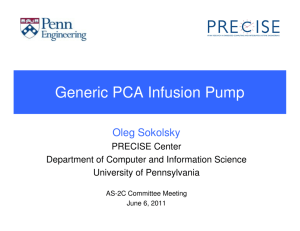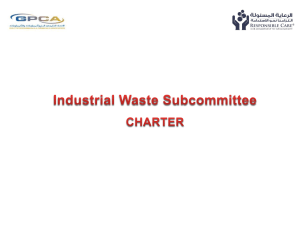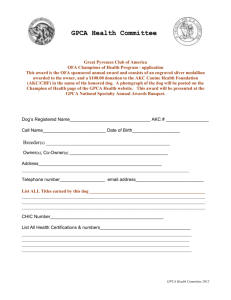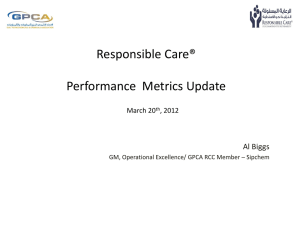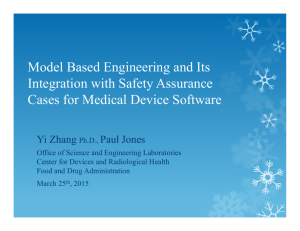4.6 MB
advertisement
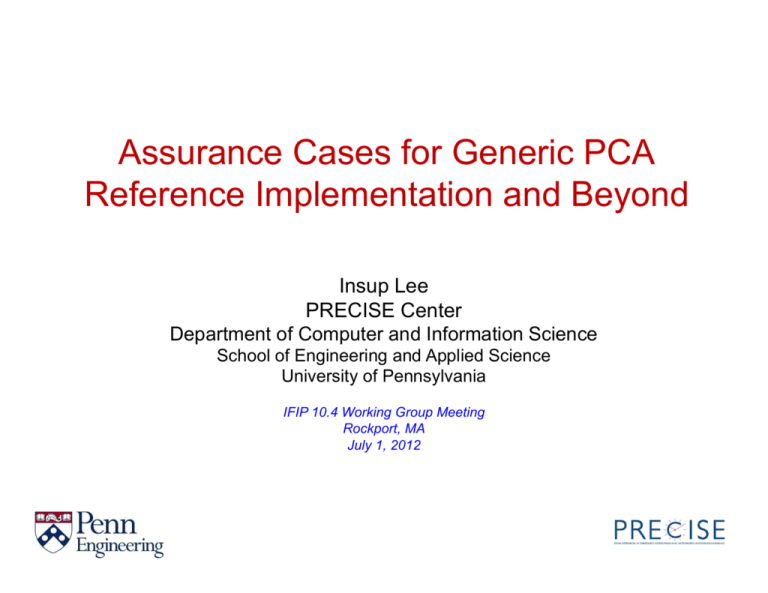
Assurance Cases for Generic PCA
Reference Implementation and Beyond
Insup Lee
PRECISE Center
Department of Computer and Information Science
School of Engineering and Applied Science
University of Pennsylvania
IFIP 10.4 Working Group Meeting
Rockport, MA
July 1, 2012
Trends in Medical Cyber-Physical Systems
(MCPS)
Autonomy
• Smart alarms
Miniaturization
Interoperation
• Implantable devices • Executable clinical
• Ingestible sensors
scenarios
• Safety interlocks
• Context-sensitive
decision support
Teleoperation
• Tele-ICU
• Physiological closed
loop control
• Robotic surgery
MCPS Research Challenges (partial list)
• High-confidence medical device software
systems (HCMDSS)
– Model-based and evidence-based
development
– Patient modeling and simulation
– User-centered design
• Medical device integration and
interoperation
• Adaptive patient-specific algorithms
• Incremental and compositional methods
for certifiable assurance and safety
Safety-Assured Model-Based
Development of
GPCA Infusion Pump Software
BaekGyu Kim, Anaheed Ayoub, Oleg Sokolsky, Insup Lee,
Paul Jones, Yi Zhang, and Raoul Jetley
Infusion Pump Safety
• During 2005 and 2009, FDA received
approximately 56,000 reports of
adverse events associated with the use
of infusion pumps
• 1% deaths, 34% serious injuries
• 87 infusion pump recalls to address
safety problems
• The most common types of problems
– Software Defect
– User Interface Issues
– Mechanical or Electrical Failure
U.S. Food and Drug Administration, Center for Devices and Radiological Health. White
Paper: Infusion Pump Improvement Initiative, April 2010
Generic Infusion Pump (GIP) Project
• The Goal of GIP Project
– To develop a set of generic infusion
pump (safety) models and reference
specification that can be used as a
reference standard to verify safety
properties in different classes of
infusion pumps
• GIP web site
• provide a repository of medical device
artifacts for use in projects that
advance the science and practice of
developing high-confidence medical
devices, software, and systems, and
• establish infusion pump safety
reference models
• Open contribution
• http://rtg.cis.upenn.edu/gip.php3
Generic PCA (GPCA)
•
Generic PCA (Patient Controlled Analgesic)
Infusion pump
– GPCA hazard analysis
– GPCA safety requirements
– GPCA reference model
•
GPCA
Goals
– Demonstrate the use of model-based
development techniques for engineering
medical device software
– Provide a base open-source reference model
that can be extended and modified to develop
specific implementations of PCA pump
software
– Provide an example assurance cases for
medical device
– Provide generic test suites (*)
– Provide a reasonably complex medical design
for researchers to use in developing, refining,
and improving theories and methods needed
to develop certifiably dependable medical
devices
– http://rtg.cis.upenn.edu/medical/gpca/
gpca.html
PCA Pump
Generic PCA (GPCA) Project
GPCA Hazard
Analysis
Assurance Case
Hazard Analysis
Model-Based
Implementation
GPCA Model
Safety
Requirements
Reference
Model
GPCA Safety
Requirements
FDA’s GPCA Model
• An abstract representation of software used in a typical PCA
infusion pump.
• The model is built in Simulink and Stateflow.
• State Controller
– Describes a drug administration process such
as parameter setting and bolus request.
• Alarm Detecting Component
– Check hardware conditions and process alarm
on any hardware failure.
State
Controller
• GPCA Environment
• User Interface
• System model
• The GPCA model interacts with pump
hardware such as motor and sensors
through the System Model.
The System Architecture of GPCA Model
FDA’s GPCA Safety Requirements
• A minimum set of generic safety requirements that can
be used to evaluate and verify infusion pump software*
– (e.g.) No normal bolus doses should be administered when the
pump is alarming (in an error state).
– (e.g.) If the calculated volume of the reservoir is y ml, and an
infusion is in progress, an Empty Reservoir alarm shall be
issued.
– (e.g.) The pump shall issue an alert if paused for more than t
minutes.
* Raoul Jetley and Paul Jones. Safety Requirements based Analysis of Infusion Pump Software.
Proceedings of the Workshop on Software and Systems for Medical Devices and Services,
December 2007.
GPCA reference implementation
• FDA initiated
– GPCA Safety Requirements
– GPCA Model (Simulink/Stateflow)
• Goal: Develop a GPCA reference
implementation
• Provide evidence that the
implementation satisfies the safety
requirements
– Code synthesis
• Organize evidence for certification
– Safety cases
– Confidence cases
• All artifacts to be available as open
source
– [AADL case study by KSU]
Safety
Requirements
GPCA Model
Formal Modeling &
Verification
Automated
Implementation
Testing
GPCA Reference
Implementation
Model-Based Development of
GPCA Reference Implementation
Part 1: Formal Verification Part
Test sequences
GPCA Safety Requirements
GPCA Model
(Simulink/Stateflow)
Test sequences
Manual translation
Manual translation
UPPAAL Queries
UPPAAL Model
Formal Verification
Code-Synthesis
(TIMES tool)
Manual
Implementation
Platform-Independent Code
(C code)
Glue-Code
Verification Result (Yes/No)
Model Trace
Validation Result
Validation
Implementation
Trace
External Channels
Clock Source
Code-Interfacing
Compilation
Executable Image
of the target platform
UPPAAL (UPPsala + AALborg = UPPAAL)
• UPPAAL is a tool for Modeling,
Validation, and Verification
• Major functionalities:
◦ A description language: network of timed
automata extended with variables.
◦ A Simulator : validation tool which enables
examination of possible executions of a
system.
◦ A Model-checker: for automatic verification of
safety properties by reachability analysis of
the symbolic state-space.
Formalization of the FDA’s GPCA model
• Transform the GPCA model into a network of UPPAAL
automata
– Retain as much of the architecture of the GPCA model as possible
following a rigorous manual translation process
– Maintain one-to-one mapping between states, conditions, user
actions, and transitions in the two models
• State : Alarm-Empty-Reservoir
• Condition : Cond-6-2 (An infusion error Empty Reservoir is detected
during the ongoing infusion process.)
• Action : E-RequestBolus (Request for a bolus dose by pressing a
button)
– Currently the UPPAAL model consists of approximately 50 states,
100 transitions, and 50 user actions and conditions
Formalization of the FDA’s GPCA model
The GPCA State Controller
Formalization of the FDA’s GPCA model
The GPCA State Controller
Formalization of the FDA’s GPCA model
The GPCA State Controller
Environment: User Actions
Environment : Hardware Conditions
Cond-6-3 implies “An infusion error Empty Reservoir is
detected during the ongoing infusion process”
Formalization of the Safety Requirements
•
•
Safety requirements are translated into temporal logic formula using the
UPPAAL query language.
Example of Safety requirement formalization
– No bolus dose shall be possible during the POST
• A[] (! (POST.Post-In-Progress && ISSM.BolusRequest))
– No normal bolus doses should be administered when the pump is alarming (in an
error state).
• A[](! (ISSM.BolusRequest && CDR.Alrm-UnknownDrug))
– The pump shall issue an alert if paused for more than t minutes
• (ISSM.InfusionPaused && x1 > MAX-PAUSED-T)
-> ISSM.Alrm-TooLongInfusionPause
– If the calculated volume of the reservoir is y ml, and an infusion is in progress, an
Empty Reservoir alarm shall be issued.
• (ISSM.Infusion-NormalOperation && Cond-6-3== true )
-> ISSM.Alrm-EmptyReservoir
Formalization of the Safety Requirements
•
•
Not all 97 safety requirements can be translated into temporal logic formula.
Categorization of the safety requirements.
Category 1) A safety requirement can be formalized and verified in the UPPAAL
model. (~20 out of 97 requirements)
•
•
No bolus dose shall be possible during the POST
The pump shall issue an alert if paused for more than t minutes
Category 2) A safety requirement can be formalized, but the GPCA model needs
additional information to verify it. (~23 out of 97 requirements)
•
If the suspend occurs due to a fault condition, the pump shall be stopped immediately
without completing the current pump stroke.
Formalization of the Safety Requirements
•
•
Not all safety requirements can be translated into temporal logic formula.
Categorization of the safety requirements.
Category 1) A safety requirement can be formalized and verified in the UPPAAL
model. (~20 out of 97 requirements)
•
•
No bolus dose shall be possible during the POST
The pump shall issue an alert if paused for more than t minutes
Category 2) A safety requirement can be formalized, but the GPCA model needs
additional information to verify it. (~23 out of 97 requirements)
•
If the suspend occurs due to a fault condition, the pump shall be stopped immediately
without completing the current pump stroke.
Category 3) A safety requirement cannot be formalized, but can be validated at the
implementation level. (~31 out of 97 requirements)
•
The flow rate for the bolus dose shall be programmable.
Category 4) A safety requirement cannot be formalized because the statement is too
vague or related to the environment of the GPCA model. (~23 out of 97
requirements)
•
•
Flow discontinuity at low flows should be minimal (“minimal” is not clear).
A key that is depressed shall not be identified as a distinct key press for a period of t
seconds (related to UI).
Part 2: Implementation
Test sequences
GPCA Safety Requirements
GPCA Model
(Simulink/Stateflow)
Test sequences
Manual translation
Manual translation
UPPAAL Queries
UPPAAL Model
Formal Verification
Code-Synthesis
(TIMES tool)
Manual
Implementation
Platform-Independent Code
(C code)
Glue-Code
Verification Result (Yes/No)
Model Trace
Validation Result
Validation
Implementation
Trace
External Channels
Clock Source
Code-Interfacing
Compilation
Executable Image
of the target platform
Code Synthesis
• Advantages of automated implementation
– An automated implementation improves the
quality of embedded software by preserving
the properties of model verification.
• Practical obstacles in automated
implementation
– There is a gap between abstract model and
implementation
TIMES
(Tool for Modeling and Implementation of Embedded Systems)
• TIMES is a tool set for modeling, schedulability analysis, synthesis of
executable code:
◦ Modeling – timed automata extended with tasks
◦ Analysis – simulator and model checker of UPPAAL
◦ Code synthesis – from timed automata model to C-code for either
Brick OS or platform-independent
GPCA Implementation Testbed
GPCA Implementation
(Beagleboard-OMAP 3530)
User Interface
TCP/IP Connection
(to Tester)
• We note that the Android UI design is motivated from CADD –Solis Ambulatory
Infusion System. The functionalities are instantiated from the GPCA model.
Sensor/Actuator
Controller
(Atmega1281)
RS232 Connection
(to Controller)
Gap: Synchrony Assumption in Modeling
c Model
Abstract
Concrete
Implementation
•
Synchrony Assumption
– The program reacts to external events
instantaneously.
– Pros: greatly simplifies formal analysis
of real-time systems.
– Cons: real systems cannot guarantee
the assumption due to computation
delay.
External Event
1.
2.
3.
4.
5.
Read Time
Read Input
Input-Transition
Write Output
Output-Transition
Computation Phase
read_time(x) input_trans(x,ia)
read_input(ia)
write_output (oa)
Real-time
output_trans(x,oa)
Types of the GPCA Pump Source Code
1. GPCA model code (Platform-independent)
– GPCA model is synthesized into C-code using TIMES tool.
– This code implements control-flow of the GPCA model depending
on user-action and hardware conditions.
2. Glue code to interface to the target platform (Platformdependent)
– Clock implementation using the target platform APIs.
– Environmental interface (for user and GPCA hardware).
3. Code for abstracted functionalities
– Pump-motor driving code on transition to Infusion-Normal-Operation
to inject drug to patient (e.g., providing electrical signal to the pump
motor)
– Code for updating dose rate on ChangeDoseRate state (e.g.,
maintaining variables for dose rate that is updated by user request)
Part 3: Validation
• Safety Requirement : The pump shall issue an alarm if paused for more then t minutes
<Model Trace>
<Implementation Trace>
<Injecting drugs>
Pause button!
Yes, Pause!
Alarm?
<Stop infusion
Session>
The GPCA UPPAAL model
transformed from FDA’s GPCA model
(Infusion Session Submachine)
The Tester screenshot
Abbott/Hospira Lifecare 4100 PCA PLUS II
Baxter PCA II Syringe Pump
Challenge: time & i/o determinism
• How to ensure that a target platform correctly executes
the generated code?
• What should be the notion of correctness?
Model
Platform Independent
Code
Platform Independent
Code
Glue-Code
Platform Dependent
Code
Approach: Infusion Pump Virtual Machine
Model
IPVM Code
<Infusion Pump A>
<Infusion Pump B>
Code Execution
IPVM Code
IPVM-Code
Interpreter Interface
Platform Independent Part
Interpreter Interface
SOF
SOF
Input
Interface
Input
Device1
Input
Interface
Output
Interface
Output
Device1
Platform Dependent Part
Output 1
Input
Device2
Output
Interface
Output
Device2
Output 2
Input
Current and Future Work
• Refine and complete the development…
– Extend requirements to include security & privacy requirements
• Identify generic-platform dependent & specific-platform
dependent glue code
– How much need to be redone with a different pump hardware
• Assurance/safety cases for the GPCA reference
implementation
– Mock FDA submission
Assurance Cases
• To construct an assurance
case we need to:
– make an explicit set of claims
about the system
– produce the supporting
evidence
– provide a set of arguments
that link the claims to the
evidence
– make clear the assumptions
and judgments underlying the
arguments
• Safety case is a special kind:
– Claims are limited to safety
Context
Goal
Strategy
Sub-Goal
Evidence
Sub-Goal
Evidence
The GPCA Safety Argument
The GPCA Safety Argument
Current Work
• Define a pattern for model-driven
development approaches (MDD pattern)
• How to identify gaps in (GPCA) assurance
cases
• How to evaluate (GPCA) assurance cases
Assurance Case Patterns
• Extended
notation
to represent
patterns
• Each pattern needs to
be appropriately
documented
Indicates
possible
alternatives
MDD pattern (from-to pattern)
Mapping the Model-Based Approach to the MDD
pattern
(1)
modeling the
system
(2)
verifying this
model
(3)
transformation the model
into an implementation
(4)
validating the
implementation
The PCA Safety Case – Instance of the MDD
pattern
Confidence Arguments
• Separate safety argument from confidence argument
• Safety argument
– Reasoning about safety of the system
• E.g.: why this hazard sufficiently unlikely to occur? Does the testing
results show that?
• Confidence argument
– Reasoning about confidence in safety argument, assumptions,
evidence
• E.g.: is that testing exhaustive? Is there sufficient confidence in the
testing? Is the model checking tool trustworthy?
Confidence Arguments Construction
• We need a mechanism to
– Systematically construct confidence arguments
– Identify safety gaps (assurance deficits)
• Generalize experience from GPCA case study
– Identify common characteristics of concepts needed in
confidence argument
– Summarize relationship between the concepts in a map
• We target trustworthiness
• Another aspect is appropriateness, which can be handled similarly
Common Characteristics Map
CCMap Instantiation
• Given a safety
argument element
The common
characteristics map
The Safety Argument
Context or Evidence
AND
Instantiate the common
characteristics map
– pick the corresponding
map node
– Unroll the map
– Find affected map nodes,
repeat
Instantiated CCMap
Generate Confidence Argument
• Near-isomorphic
structure
Identify safety gaps
• Look for branches that
do not end with
evidence nodes
Evaluate the Safety Argument
• Assurance cases are, by their nature, often subjective.
• One of the purposes of assurance case development,
therefore, is to facilitate mutual acceptance of this subjective
position.
• The goal of assurance case evaluation, therefore, is to assess
if there is a mutual acceptance of the subjective position.
• Need an approach/method
– Experts should only be required to express their opinions about the
basic elements in argument structures (e.g., assumptions,
evidences)
– A systematic mechanism should provide a way to aggregate the
opinions to communicate a message about the argument overall
sufficiency.
Evaluate the Safety Argument
• The proposed method consists of two steps
– Step 1: Assign degree of belief in the sufficiency and
insufficiency of the basic elements of the argument
– Step 2: Aggregation
• Starting from the leaves,
– aggregate the degree of beliefs in the sufficiency/insufficiency in the
premises (e.g., the evidence)
– to obtain the degree of belief in the sufficiency/insufficiency in the
conclusion (i.e., the goal).
• Repeat the process until the top-level goal has been reached
How to evaluate Safety Argument
• The argumentation type
Ev1
Ev1
Ev2
Case #1
Alternative
Ev
1
Ev
2
Ev1
Ev2
Ev
1
Case #2
Disjoint
Case #3
Overlap
G1
Ev1
Ev2
Ev2
Case #4
Containment
Medical-Device Plug-and-Play
Characteristics
Current!
• Medical devices gaining
communication capabilities !
• Devices still operate
independently
• Standardized interaction
between devices non existent
• Full benefit of communication
capabilities not being realized
Future!
Advantages
MD PnP: Interoperable medical devices based
on plug-n-play!
Vendor neutrality based on open medical device
interfaces
www.mdpnp.org
• Improve Patient safety
• Safety interlocks
• Complete, accurate
medical records
• Reduce errors
• Context awareness
• Rapid deployment
Integrated Clinical Environment (ICE)
•
Supervisor
App
A1
App
A2
…
App
An
ICE App Code Language / Virtual Devices
Network Controller (NC)
ICE EI Interface Description Language
Ice Equipment
Interface (EI)
I1
EI
Adapter
Physical
Device
Native
EI-Compliant
Physical
Device
Ice Equipment
Interface (EI)
I3
EI
Adapter
Physical
Device
•
•
ASTM Standard F2761-2009 for ICE
defines a high-level architecture and
functional concept
Subsequent standards are intended
to provide specific functional and
interfacing requirements for
components
The ICE architecture standard is the
focal point for FDA s evaluation of
MAP concepts in future medical
systems
– A key element of this evaluation is
moving from regulation of systems
as a whole to component-wise
regulation
PCA Closed-loop System
• Goal: Improve the safety of PCA
uses
• Approach: Integrate monitors
with an intelligent “controller” to:
– Detect respiratory disturbance
– Safety lock over infusion
– Activate nurse-call
PCA Pump
(with patient button)
ADAPTER
Network
Controller
ADAPTER
Nurse call
Supervisor
Monitoring system
Patient
Virtual Medical Devices (VMD)
• MD PnP enables the concept of Virtual Medical Devices:
– A set of medical devices coordinating over a network for clinical
scenario.
+
Device Coordination
Algorithm
=
Medical Device Types
Virtual Medical Device
(VMD)
• VMD does not physically exist until instantiated at a hospital.
• The Medical Device Coordination Framework (MDCF) is
prototype middleware for managing the correct composition of
medical devices into VMD.
MDCF/MIDAS
•
•
Clinician selects appropriate
VMD
MDCF binds appropriate
devices into VMD instance
MDCF displays
VMD GUI for
clinician
Certification of VMD App
• Safety analysis of the VMD model relies on assumptions
about
– Devices that comprise the VMD
– Interoperability infrastructure
• Current regulatory approach:
– Certify each instantiation of VMD app
• fixed medical devices, network, middleware, etc.
• Alternative approach:
– Certify VMD app based on abstract interfaces
– Certify devices on interface satisfaction
– System can use any certified component
Traditional safety critical systems...
Nuclear
Aerospace
Automotive
System Integration
In other safety critical domains, there is a typically a prime contractor that is responsible for
integration and system-level verification and validation.
!
!
!
Integration is performed before
deployment with full knowledge and
behavior of components being
integrated
Integrator has expert-level technical
knowledge of components & system
behavior
Responsible for overall system
!
Verification & Validation
!
Safety arguments
!
Certification
System Integration
In other safety critical domains, there is a typically a prime contractor that is responsible for
integration and system-level verification and validation.
ConOps
Requirements
End to end
process
managed by
prime
contractor.
Design
Deployment
Systems
V&V
Integration
Subsystems
Implementation
System integration and V & V is
done before system is delivered to
the customer.
VMD Development & Assembly
VMD App
Medical Device
Manufacturer VMD PlatformDeveloper
Manufacturer
App Execution
Performed by
runtime
environment
of VMD
ConOps
Requirements
Performed by
clinical staff
Design
Impl / V & V
Market
(dynamic formation of
MAP constituted device)
VMD Instance
Assembly
Deployment
VMD Characteristics
In other safety critical domains, there is a
typically a prime contractor that is
responsible for integration and system-level
verification and validation.
!
!
!
Integration is performed before
deployment with full knowledge and
behavior of components being
integrated
Integrator has expert-level technical
knowledge of components & system
behavior
Responsible for overall system
!
Verification & Validation
!
Safety arguments
!
Certification
With VMDs, there is no prime contractor
that is responsible for integration and
system-level verification and validation.
!
!
!
!
!
Assembly is performed after deployment
Assembler (hospital staff) does not have
expert-level technical knowledge of
components & system behavior
App developer is responsible for overall
system safety arguments
Platform services (compatibility checks)
assist in determining at app launch
time if platform and attached devices
satisfy requirements of app
The app s directions for assembly of the
platform constituted device are stated
only in terms of properties/
capabilities that are exposed on the
interfaces of the platform and devices.
Regulatory Process
• “pair-wise” approval
– Approve every possible permutation of devices forming a
composite medical system
– It is simply not viable
• “component-wise” approval
– Approve each system component
• “component x is safe for its intended use in its intended use
environment”
• Part of component x’s intended use is to interacts with other
components according to their intended use
Pairwise Approval / Certification
Example interoperable device ecosystem 3 different (model/manufacturer) SpO2
monitors, 3 different (model/manufacturer) PCA infusion pumps:
Sensors
Pumps
S1
P1
S2
P2
S3
P3
Each sensor must be approved or
certified for use with each pump and
vice versa. This is burdensome for
manufacturers and regulators
Certification or
approval relationship
Interface-based approval / certification
Example interoperable device ecosystem 3 different (model/manufacturer) SpO2
monitors, 3 different (model/manufacturer) PCA infusion pumps:
Pumps
Sensors
S1
Interoperable
Sensor
Spec
Interoperable
Pump
Spec
P1
S2
IS
IP
P2
S3
Composition of sensor satisfying IS and pump
satisfying IP is shown to be safe and effective
Each sensor (or pump) only needs certification or
approval w.r.t. the interface spec. Additionally, the
ecosystem can grow without forcing
recertification (or re-approval) of previously
analyzed devices
P3
Certification or
approval relationship
Modular Assurance Case
• The assurance case for a system of systems would be
an assurance case of assurance cases (i.e., tree of
trees)
Caregiver
Caregiver’s User Interface
Supervisor
External
Network
Network Controller
Adapter
Adapter
Device
Device
Data
Logger
Patient-Centered
Data Network
Device
Physical Connection to Patient
Patient
Modular Assurance Case --Example
fig 1
SysAccSafe
{System X} is
acceptably safe
SRFunctions
Safety Related
functions of
{System X}
ArgOverFunctions
Argument over all identified
safety related functions of
{System X}
Public Goal
FunctionsInd
All functions are
independent
IndependenceArg
FnASafe
Function A operation
is acceptably safe
FnBSafe
Function B operation
is acceptably safe
FnCSafe
Function C operation
is acceptably safe
FnBArgument
Module
Reference
FnAArgument
Safety Argument for
Function A
‘Away’
Goal
Modular Assurance Case
–
–
–
–
An assurance case for the supervisor
An assurance case for the Network Controller
An assurance case for each device
An assurance case for each virtual medical device (VDM) app
• It is safe
• It is compliant with VDM interfaces
Caregiver
Supervisor
External
Network
Network Controller
Adapter
Adapter
Device
Device
Patient
Caregiver’s User
Interface
Data
Logger
Patient-Centered
Data Network
Device
Physical Connection to
Patient
The network controller safety case
The network controller safety case
• The top part
Summary
• In order for assurance cases to work in practice,
we need to
– Develop effective ways to construct them
– Systematically assess the arguments
• Based on our experience with the GPCA case
study
– MDD pattern
– The safety gaps identification
– Evaluation mechanism
• Assurance cases for MDPnP
– Construct a modular assurance case (assurance case of
assurance cases)
MCPS Research at PRECISE Center
• High-confidence medical software systems
– Model-based development
– Open source reference implementation of GPCA (Generic PatientControlled Analgesia) infusion pump
– Pacemaker and heart modeling and analysis
– Mental models
• Medical device interoperability
– Security and Privacy
• Smart alarms & clinical decision support
• Physiological closed-loop systems
– Safe controllers
• Assurance and Certification
– Evidence-based certification
– Blackbox recorder for medical device
MCPS Team Members
•
Penn, SEAS
–
–
–
–
–
–
•
Penn, UPHS/SoM
–
–
–
–
•
Insup Lee (PI)
Rajeev Alur
Rahul Mangharam
George Pappas
Rita Powell
Oleg Sokolsky
William Hanson, III, MD
Margaret Mullen-Fortino, RN
Soojin Park, MD
Victoria Rich, RN, PhD
Penn, Sociology, SAS
– Ross Koppel
•
MGH/CIMIT
– Julian Goldman, MD
•
Minnesota
–
–
–
–
•
Mats Heimdahl
Nicholas Hopper
Yongdae Kim
Michael Whalen
Waterloo
– Sebastian Fischmeister
•
Collaborators
–
–
–
–
John Hatcliff, KSU
Paul Jones, FDA
Sandy Weininger, FDA
Zhang Yi, FDA
• CPS: Large: Assuring the Safety, Security and Reliability of Medical Device
Cyber Physical Systems (NSF CNS-1035715)
• NSF FDA Scholar In Residence (NSF CNS-1042829)
• Affiliated Project: Medical Device NIH/NIBIB Quantum Grant: Development of a
Prototype Healthcare Intranet for Improved Health Outcomes (PI: Julian
Goldman)
Acknowledgements
• Domain knowledge comes from our collaborators at the
UPenn Hospital and MD PnP program at CIMIT
– Julian Goldman, MD
– Margaret Mullen-Fortino, RN
– Soojin Park, MD
• VMD concepts are developed in collaboration with KSU
(John Hatcliff) and MD PnP Quantum (Julian Goldman)
project
• Some of the slides are courtesy of Julian Goldman, John
Hatcliff, Oleg Sokolsky, and Andrew King
• Work support by NSF CPS and NIH grants
THANK!YOU!!
http://precise.seas.upenn.edu

